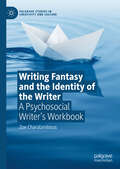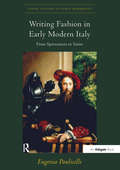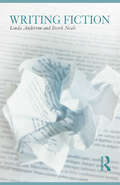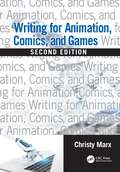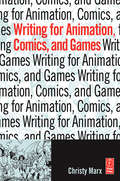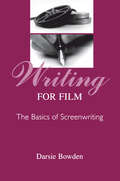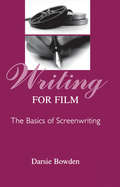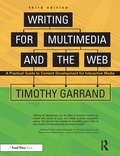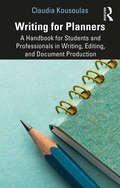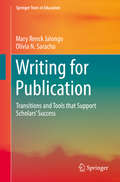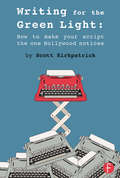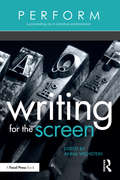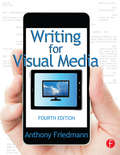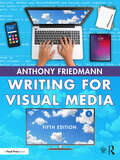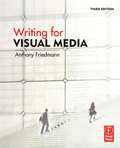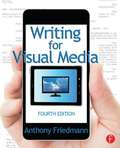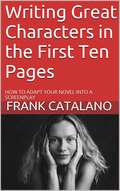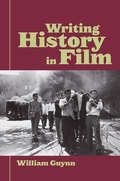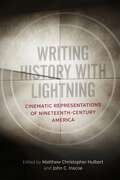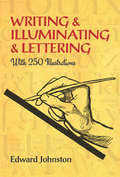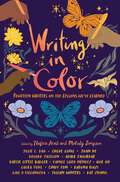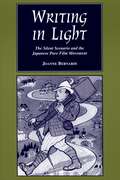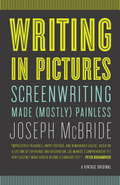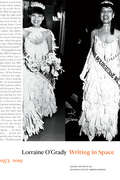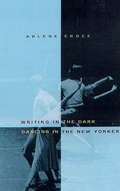- Table View
- List View
Writing Fantasy and the Identity of the Writer: A Psychosocial Writer’s Workbook (Palgrave Studies in Creativity and Culture)
by Zoe CharalambousThis book presents the innovative pedagogy of Writing Fantasy: a method for exploring and shifting one’s identity as a writer. The book draws on qualitative research with undergraduate creative writing students and fills a gap in the literature exploring creative writing pedagogy and creative writing exercises. Based on the potential to shift writer identity through creative writing exercises and the common ground that these share with the stance of the Lacanian analyst, the author provides a set of guidelines, exercises and case studies to trace writing fantasy, evidenced in one’s creative writing texts and responses about creative writing. This innovative work offers fresh insights for scholars of creativity, Lacan and psychosocial studies, and a valuable new resource for students and teachers of creative writing.
Writing Fashion in Early Modern Italy: From Sprezzatura to Satire (Visual Culture in Early Modernity)
by Eugenia PaulicelliThe first comprehensive study on the role of Italian fashion and Italian literature, this book analyzes clothing and fashion as described and represented in literary texts and costume books in the Italy of the 16th and 17th centuries. Writing Fashion in Early Modern Italy emphasizes the centrality of Italian literature and culture for understanding modern theories of fashion and gauging its impact in the shaping of codes of civility and taste in Europe and the West. Using literature to uncover what has been called the ’animatedness of clothing,’ author Eugenia Paulicelli explores the political meanings that clothing produces in public space. At the core of the book is the idea that the texts examined here act as maps that, first, pinpoint the establishment of fashion as a social institution of modernity; and, second, gauge the meaning of clothing at a personal and a political level. As well as Castiglione’s The Book of the Courtier and Cesare Vecellio’s The Clothing of the Renaissance World, the author looks at works by Italian writers whose books are not yet available in English translation, such as those by Giacomo Franco, Arcangela Tarabotti, and Agostino Lampugnani. Paying particular attention to literature and the relevance of clothing in the shaping of codes of civility and style, this volume complements the existing and important works on Italian fashion and material culture in the Renaissance. It makes the case for the centrality of Italian literature and the interconnectedness of texts from a variety of genres for an understanding of the history of Italian style, and serves to contextualize the debate on dress in other European literatures.
Writing Fiction
by Linda Anderson Derek NealeWriting Fiction offers the novice writer engaging and creative activities, making use of insightful, relevant readings from well-known authors to illustrate the techniques presented. This volume makes use of new versions of key chapters from the recent Routledge/Open University textbook Creative Writing: A Workbook with Readings for writers who are specializing in fiction. Using their experience and expertise as teachers as well as authors, Linda Anderson and Derek Neale guide aspiring writers through such key aspects of writing as: how to stimulate creativity keeping a writer’s notebook character creation setting point of view structure showing and telling. The volume is further updated to include never-before published interviews with successful fiction writers Andrew Cowan, Stevie Davies, Maggie Gee, Andrew Greig, and Hanif Kureishi. Concise and practical, Writing Fiction offers an inspirational guide to the methods and techniques of authorship and is a must-read for aspiring writers.
Writing for Animation, Comics, and Games
by Christy MarxThis second edition of Writing for Animation, Comics, and Games expounds on the previous edition with more information on how to construct narratives for these three forms of visual storytelling media. Christy Marx’s book offers an in-depth look into scriptwriting and how to break into each of the featured industries. The text goes into detail on visual storytelling: how to compose exterior storytelling (animation, games) and interior/exterior storytelling (comics and graphic novels); as well as considerations for non-linear videogames. The advice within these pages can be used to build a transmedia career across animation, comics, graphic novels, and videogames. Key Features An insider's perspective on career rules of the road on writing for comics, videogames, and animation Written for beginners and professionals alike A nuts-and-bolts guide to script formats, terminology, networking, and valuable advice on writing for each medium Author Bio Based in Northern California, Christy Marx is an award-winning writer, story editor, TV series developer, game designer, and narrative designer. Her many credits include Babylon 5; Captain Power and Soldiers of the Future; The Twilight Zone; G.I. Joe; Jem and the Holograms; Spider-Man; He-Man; X-Men Evolution; Teenage Mutant Ninja Turtles; Conan the Adventurer; Birds of Prey; Amethyst; The Sisterhood of Steel; Sierra On-Line adventure games; PC, MMO, and console games; Zynga mobile games; and more. For full credits, visit www.christymarx.com.
Writing for Animation, Comics, and Games
by Christy MarxWriting for Animation, Comics, and Games explains the practical aspects of creating scripts for animation, comics, graphic novels, and computer games. It details how you can create scripts that are in the right industry format, and follow the expected rules for you to put your best foot forward to help you break-in to the trade. This book explains approaches to writing for exterior storytelling (animation, games); interior/exterior storytelling (comics and graphic novels), as well as considerations for non-linear computer games in the shortest, pithiest, and most economical way. The author offers insider's advice on how you can present work as professional, how to meet deadlines, how visual writing differs from prose, and the art of collaboration.
Writing for Film: The Basics of Screenwriting
by Darsie BowdenIn this introduction to screenwriting, author Darsie Bowden provides sage, real-world advice and instruction on the process of writing film screenplays. This text will help budding screenwriters to structure their dramas, refine their characterizations, and craft their language, while also introducing them to the appropriate screenplay formats. It covers the complexities of writing for the screen and points out the contradictions to expect if readers pursue this work as a career. In addition to covering the elements of the dramatic film screenplay, Bowden discusses writing for such "alternative" markets as documentaries, independent films, experimental films, and other non-Hollywood options. Features of the text include:guidelines for working as a screenwriter;applications and exercises to enhance skills;suggested readings for further development; anda comprehensive list of resources for screenwriting.Successful writing for film lies in being able to heighten one's perceptive abilities about the world and to communicate those perceptions in a cinematic way. In this text, Bowden introduces readers to an approach to screenwriting that will help them see the world in a different way and write about it using different genres and media. This most valuable skill prepares readers for the range of possibilities they will encounter on the path to successful screenwriting.
Writing for Film: The Basics of Screenwriting
by Darsie BowdenIn this introduction to screenwriting, author Darsie Bowden provides sage, real-world advice and instruction on the process of writing film screenplays. This text will help budding screenwriters to structure their dramas, refine their characterizations, and craft their language, while also introducing them to the appropriate screenplay formats. It covers the complexities of writing for the screen and points out the contradictions to expect if readers pursue this work as a career. In addition to covering the elements of the dramatic film screenplay, Bowden discusses writing for such "alternative" markets as documentaries, independent films, experimental films, and other non-Hollywood options. Features of the text include:guidelines for working as a screenwriter;applications and exercises to enhance skills;suggested readings for further development; anda comprehensive list of resources for screenwriting.Successful writing for film lies in being able to heighten one's perceptive abilities about the world and to communicate those perceptions in a cinematic way. In this text, Bowden introduces readers to an approach to screenwriting that will help them see the world in a different way and write about it using different genres and media. This most valuable skill prepares readers for the range of possibilities they will encounter on the path to successful screenwriting.
Writing for Multimedia and the Web: A Practical Guide to Content Development for Interactive Media
by Timothy GarrandLearning how to write for just one type of interactive media, such as web sites or games, is not enough! To be truly successful as an interactive writer or designer, you need to understand how to create content for all types of new media.Writing for Multimedia and the Web is the most comprehensive guide available for interactive writing. It covers web sites, computer games, e-learning courses, training programs, immersive exhibits, and much more. Earlier editions have garnered rave reviews as a writing handbook for multimedia and web professionals, as well as a classroom text for interactive writing and design.New Sections and Completely Updated Chapters:*Writing a corporate web site: T. Rowe Price*Creating blogs and podcasts*Web writing tips from usability experts*Optimizing text for web search engines*Defining the user with use cases and user scenarios*Dealing with web editors*Software for organizing and writing interactive media content*Script formats for all types of multimedia and web projects*Writing careers
Writing for Planners: A Handbook for Students and Professionals in Writing, Editing, and Document Production
by Claudia KousoulasWriting is never easy, but this book can make it easier. With attentiveness and experience, Claudia Kousoulas gives readers applied writing, editing, and production approaches that provide a clear path to completing a document and tools that ensure it is engaging and professional. The book follows a project’s path from initial assignment and conception, through sorting out what’s significant, shaping it into a message, and guiding readers to an action. It addresses the different types of documents planners have to create, the different media they use, and the different audiences they address. Its strategies will help writers start a project and see it through to a clear and coherent piece of work that serves its purpose. This book will help planners meet the challenges of creating work that is accurate, creative, and useful. Students will find it helpful in providing professional standards and quick reference information, and professionals will carry it through their careers as a reference, and as a way to establish workplace standards and improve their own work.
Writing for Publication
by Mary Renck Jalongo Olivia N. SarachoThis book offers systematic instruction and evidence-based guidance to academic authors. It demystifies scholarly writing and helps build both confidence and skill in aspiring and experienced authors. The first part of the book focuses on the author's role, writing's risks and rewards, practical strategies for improving writing, and ethical issues. Part Two focuses on the most common writing tasks: conference proposals, practical articles, research articles, and books. Each chapter is replete with specific examples, templates to generate a first draft, and checklists or rubrics for self-evaluation. The final section of the book counsels graduate students and professors on selecting the most promising projects; generating multiple related, yet distinctive, publications from the same body of work; and using writing as a tool for professional development. Written by a team that represents outstanding teaching, award-winning writing, and extensive editorial experience, the book leads teacher/scholar/authors to replace the old "publish or perish" dictum with a different, growth-seeking orientation: publish and flourish.
Writing for the Green Light: How to Make Your Script the One Hollywood Notices
by Scott KirkpatrickTailor your screenplay to sell. Find out what Hollywood script readers, producers, and studio executives want in a screenplay (and why) from someone who’s been there. Discover what it takes to begin a lasting career as a screenwriter. Peppered with interviews from established professionals, Writing for the Green Light: How to Make Your Script the One Hollywood Notices gives you a sharp competitive edge by showcasing dozens of everyday events that go on at the studios but are rarely if ever discussed in most screenwriting books. With his behind-the-scenes perspective, Scott Kirkpatrick shows you why the system works the way it does and how you can use its unwritten rules to your advantage. He answers such questions as: Who actually reads your script? How do you pique the interest of studios and decision makers? What do agents, producers, and production companies need in a script? How much is a script worth? What are the best genres for new writers and why? What are real steps you can take to ‘break in’ to television writing? How do you best present or pitch a project without looking desparate? How do you negotiate a contract without an agent? How do you exude confidence and seal your first deal? These and other insights are sure to give you and your screenplay a leg-up for success in this competitive landscape!
Writing for the Screen (PERFORM)
by Anna WeinsteinWriting for the Screen is a collection of essays and interviews exploring the business of screenwriting. This highly accessible guide to working in film and television includes perspectives from industry insiders on topics such as breaking in; pitching; developing and nurturing business relationships; juggling multiple projects; and more. Writing for the Screen is an ideal companion to screenwriting and filmmaking classes, demystifying the industry and the role of the screenwriter with real-world narratives and little-known truths about the business. With insight from working professionals, you’ll be armed with the information you need to pursue your career as a screenwriter. Contains essays by and interviews with screenwriting consultants, television writers, feature writers, writer-directors of independent film, producers, and professors. Offers expert opinions on how to get started, including preparing your elevator pitch, finding mentors, landing an internship, and moving from an internship to the next step in your career. Reveals details about taking meetings, what development executives are looking for in a screenwriter, how and when to approach a producer, and how to pitch. Explores strategies for doing creative work under pressure, finding your voice, choosing what to write, sticking with a project over the long haul, overcoming discrimination, and reinventing yourself as a writer. Illuminates the business of screenwriting in the United States (New York and Los Angeles) as compared to other countries around the globe, including England, Ireland, Peru, France, Australia, and Belgium.
Writing for Visual Media
by Anthony FriedmannThis updated edition of Writing for Visual Media will enable you to understand the nature of visual writing that lies behind the content of all visual media. This unique kind of writing must communicate to audiences through content producers, since audiences don't read the script. Most media content provides a solution to a communication problem, which the writer must learn to analyze and solve before writing the script. The Fourth Edition strengthens the method for creating content and writing in the correct language and established format for each visual medium, including commercial communication such as ads and PSAs, corporate communications, and training. An extended investigation into dramatic theory and how entertainment narrative works is illustrated by examples and detailed analysis of scenes, scripts and storylines, saving you designed to save writers from typical pitfalls and releasing your creative powers of invention. Writing for Visual Media will help you to develop an improved foundation for understanding interactive media and writing for non-linear content, while gaining the tools to effectively connect with your audience like a professional. Purchase of this book includes access to the companion website, which provides: Sample scripts and video clips of those produced scripts An interactive glossary of camera shots, movements, and transitions Storyboards, scripts, screenplays, and links to industry resource Instructor materials such as PowerPoint lecture slides, a sample syllabus, and a test bank. Visit the site at www.routledgetextbooks.com/textbooks/9780415815857
Writing for Visual Media
by Anthony FriedmannWriting for Visual Media provides writers with an understanding of the nature of visual writing behind all visual media. Such writing is vital for directors, actors, and producers to communicate content to audiences. Friedmann provides an extended investigation into dramatic theory and how entertainment narrative works, illustrated by examples and detailed analysis of scenes, scripts, techniques, and storylines. This new edition has a finger on the pulse of the rapidly evolving media ecosystem and explains it in the context of writing and creating content. Friedmann lays out many of the complex professional, creative, and commercial issues that a writer needs to understand in order to tell engaging stories and construct effective and professional screenplays. This new edition includes: A new chapter on storytelling A fresh examination of dramatic theory and how to apply it to constructing screenplays Updated discussion of mobile platforms A lengthened discussion of copyright, ethics, and professional development issues An updated companion website with sample scripts and corresponding videos, an interactive glossary, sample storyboards and screenplays, links to industry resources, and materials for instructors such as slides, a syllabus, and a test bank.
Writing for Visual Media (3rd Edition)
by Anthony FriedmannWriting for Visual Media looks at the fundamental problems a writer faces in learning to create content for media that is to be seen rather than read. It takes you from basic concepts to practice through a seven-step method that helps you identify a communications problem, think it through, and find a resolution before beginning to write. Through successive exercises, Writing for Visual Mediahelps you acquire the basic skills and confidence you need to write effective films, corporate and training videos, documentaries, web sites, PSAs, TV shows, nonlinear media, and other types of visual narratives. You'll explore your visual imagination and try out your powers of invention. The companion web site enriches the content of the printed book with video, audio, and sample scripts. It includes scripts and the video produced from them; visual demonstrations of concepts; and an interactive, illustrated glossary of terms and concepts.
Writing for Visual Media (Fourth Edition)
by Anthony FriedmannThis updated edition of Writing for Visual Media will enable you to understand the nature of visual writing that lies behind the content of all visual media. This unique kind of writing must communicate to audiences through content producers, since audiences don't read the script. Most media content provides a solution to a communication problem, which the writer must learn to analyze and solve before writing the script. The new edition strengthens the method for creating content and writing in the correct language and established format for each visual medium, including commercial communication such as ads and PSAs, corporate communications, and training. An extended investigation into dramatic theory and how entertainment narrative works is illustrated by examples and detailed analysis of scenes, scripts and storylines, saving you designed to save writers from typical pitfalls and releasing your creative powers of invention. Writing for Visual Media will help you to develop an improved foundation for understanding interactive media and writing for non-linear content, while gaining the tools to effectively connect with your audience like a professional. Purchase of this book includes access to the companion website, www. focalpress. com/cw/friedmann (coming June 5), which provides: Sample scripts and video clips of those produced scripts An interactive glossary of camera shots, movements, and transitions Storyboards, scripts, screenplays, and links to industry resource Instructor materials such as PowerPoint lecture slides, a sample syllabus, and a test bank.
Writing Great Characters in the First Ten Pages: How to Adapt Your Novel Into a Screenplay
by Frank CatalanoWriters of fiction and non-fiction and industry professionals from the publishing business primarily attended the 25th Annual Writer's Conference. Mr. Catalano's seminars focused upon those writers seeking to adapt their novels into screenplays. The complete list of seminar presentations by Frank Catalano for this conference is: BOOK 1: WRITE GREAT CHARACTACTERS IN THE FIRST TEN PAGES BOOK 2: WRITING ON YOUR FEET - IMPROVISATIONAL TECHNIQUES FOR WRITERS BOOK 3: START YOUR STORY AT THE END: FOR WRITERS BOOK 4: THE FIRST TEN PAGES BOOK 5: BOOK TO SCREEN BOOK 6: ACTING IT OUT - IMPROVISATIOINAL TECHNIQUES FOR WRITERS II BOOK 7: WRITE GREAT DIALOGUE
Writing History in Film
by William GuynnHistorical film has been an important genre since the earliest silent films. The French Revolution, the American Civil War, the conquest of the New World, World War II--all have been repeatedly represented in film. But how do we distinguish between fictionalized spectacle and authentic historical representation? Writing History in Film sets out the narratological, semiological, rhetorical, and philosophical bases for understanding how film can function as a form of historical interpretation and representation. With case studies and an interdisciplinary approach, William Guynn examines the key issues facing film students and scholars, historians, and anyone interested in how we see our historical past.
Writing History with Lightning: Cinematic Representations of Nineteenth-Century America
by Matthew C. Hulbert John C. Inscoe Kenneth Greenberg William L. Andrews Lesley J. Gordon John David Smith Jonathon Sarris Catherine Clinton John F. Marszalek Ryan Keating Joseph Beilein Brian Rouleau Donna Barbie Allison Dorsey Stephen Whitfield Marcus Rediker Nicole Etcheson Diane Miller Sommerville Graham Hodges Drew Swanson Michael Burlingame Tom Lee James Crisp Matthew Stanley Kevin Waite Jacob LeeFilms possess virtually unlimited power for crafting broad interpretations of American history. Nineteenth-century America has proven especially conducive to Hollywood imaginations, producing indelible images like the plight of Davy Crockett and the defenders of the Alamo, Pickett’s doomed charge at Gettysburg, the proliferation and destruction of plantation slavery in the American South, Custer’s fateful decision to divide his forces at Little Big Horn, and the onset of immigration and industrialization that saw Old World lifestyles and customs dissolve amid rapidly changing environments. Balancing historical nuance with passion for cinematic narratives, Writing History with Lightning confronts how movies about nineteenth-century America influence the ways in which mass audiences remember, understand, and envision the nation’s past. In these twenty-six essays—divided by the editors into sections on topics like frontiers, slavery, the Civil War, the Lost Cause, and the West—notable historians engage with films and the historical events they ostensibly depict. Instead of just separating fact from fiction, the essays contemplate the extent to which movies generate and promulgate collective memories of American history. Along with new takes on familiar classics like Young Mr. Lincoln and They Died with Their Boots On, the volume covers several films released in recent years, including The Revenant, 12 Years a Slave, The Birth of a Nation, Free State of Jones, and The Hateful Eight. The authors address Hollywood epics like The Alamo and Amistad, arguing that these movies flatten the historical record to promote nationalist visions. The contributors also examine overlooked films like Hester Street and Daughters of the Dust, considering their portraits of marginalized communities as transformative perspectives on American culture. By surveying films about nineteenth-century America, Writing History with Lightning analyzes how movies create popular understandings of American history and why those interpretations change over time.
Writing & Illuminating & Lettering: With 250 Illustrations
by Edward JohnstonOne of the founders of modern calligraphy, Edward Johnston regarded lettering, writing, and illuminating as not only desirable ends in themselves but also as practical avenues to mastery of typography, decoration, and design. In this classic, profusely illustrated guide, he distilled his expertise into a series of easy-to-follow lessons that will benefit any student of calligraphy, book design, or art.Part I is devoted to writing and illuminating. Early chapters cover the fundamentals of acquiring a formal hand: choosing paper, ink, and quills; holding the pen; spacing and planning a manuscript; and more. The author then turns to the techniques of producing a manuscript book: tools and materials, methods and proportions, margins, and other methods. Part II offers a detailed discussion of lettering: the qualities of good lettering, methods of construction and arrangement, spacing, proportion, and other matters. Two appendixes cover the uses of lettering in book bindings, wall inscriptions, monograms, and title pages as well as the techniques involved in lettering on metal, wood, and stone.
Writing in Color: Fourteen Writers on the Lessons We've Learned
by Julie C. Dao Chloe Gong Joan He Kosoko Jackson Adiba Jaigirdar Darcie Little Badger Yamile Saied Méndez Axie Oh Laura Pohl Cindy Pon Karuna Riazi Gail D. Villanueva Julian Winters Kat ZhangRethink the way you approach writing in this revolutionary and informative new anthology from fourteen diverse authors that demystifies craft and authorship based on their experiences as writers of color—perfect for fans of Fresh Ink and Our Stories, Our Voices.So, you&’re thinking of writing a book. Or, maybe you&’ve written one, and are wondering what to do with it. What does it take to publish a novel, or even a short story? If you&’re a writer of color, these questions might multiply; after all, there&’s a lot of writing advice out there, and it can be hard to know how much of it really applies to your own experiences. If any of this sounds like you, you&’re in the right place: this collection of essays, written exclusively by authors of color, is here to encourage and empower writers of all ages and backgrounds to find their voice as they put pen to page. Perhaps you&’re just getting started. Here you&’ll find a whole toolkit of advice from bestselling and award-winning authors for focusing on an idea, landing on a point of view, and learning which rules were meant to be broken. Or perhaps you have questions about everything beyond the first draft: what is it really like being a published author? These writers demystify the process, sharing personal stories as they forged their own path to publication, and specifically from their perspectives as author of color. Every writer has a different journey. Maybe yours has already started. Or maybe it begins right here. Contributors include: Julie C. Dao, Chloe Gong, Joan He, Kosoko Jackson, Adiba Jaigirdar, Darcie Little Badger, Yamile Saied Mendez, Axie Oh, Laura Pohl, Cindy Pon, Karuna Riazi, Gail D. Villanueva, Julian Winters, and Kat Zhang.
Writing in Light: The Silent Scenario and the Japanese Pure Film Movement
by Joanne BernardiWhile most people associate Japanese film with modern directors like Akira Kurosawa, Japan's cinema has a rich tradition going back to the silent era. Japan's "pure film movement" of the 1910s is widely held to mark the birth of film theory as we know it and is a touchstone for historians of early cinema. Yet this work has been difficult to access because so few prints have been preserved. Joanne Bernardi offers the first book-length study of this important era, recovering a body of lost film and establishing its significance in the development of Japanese cinema. Building on a wealth of original-language sources--much of it translated here for the first time--she examines how the movement challenged the industry's dependence on pre-existing stage repertories, preference for lecturers of intertitles, and the use of female impersonators. Bernardi provides in-depth analysis of key scripts--The Glory of Life, A Father's Tears, Amateur Club, and The Lust of the White Serpent--and includes translations in an appendix. These films offer case studies for understanding the craft of screenwriting during the silent era and shed light on such issues as genre, authorship and control, and gender representation. Writing in Light helps fill important gaps in the history of Japanese silent cinema. By identifying points at which "pure film" discourse merges with changing international trends and attitudes toward film, it offers an important resource for film, literary, and cultural historians.
Writing in Pictures
by Joseph McbrideWriting in Pictures is a refreshingly practical and entertaining guide to screenwriting that provides what is lacking in most such books: a clear, step-by-step demonstration of how to write a screenplay.Seasoned screenwriter and writing teacher Joseph McBride breaks down the process into a series of easy, approachable tasks, focusing on literary adaptation as the best way to learn the basics and avoiding the usual formulaic approach. With its wealth of useful tips, along with colorful insights from master screenwriters past and present, this book is invaluable for anyone who wants to learn the craft of screen storytelling.
Writing in Space, 1973–2019
by Lorraine O'GradyWriting in Space, 1973-2019 gathers the writings of conceptual artist Lorraine O'Grady, who for over forty years has investigated the complicated relationship between text and image. A firsthand account of O'Grady's wide-ranging practice, this volume contains statements, scripts, and previously unpublished notes charting the development of her performance work and conceptual photography; her art and music criticism that appeared in the Village Voice and Artforum; critical and theoretical essays on art and culture, including her classic "Olympia's Maid"; and interviews in which O'Grady maps, expands, and complicates the intellectual terrain of her work. She examines issues ranging from black female subjectivity to diaspora and race and representation in contemporary art, exploring both their personal and their institutional implications. O'Grady's writings—introduced in this collection by critic and curator Aruna D'Souza—offer a unique window into her artistic and intellectual evolution while consistently plumbing the political possibilities of art.
Writing in the Dark, Dancing in the New Yorker
by Arlene CroceArlene Croce was The New Yorker's dance critic, a post created for her. Her entertaining, forthright, passionate reviews have revealed the logic and history of ballet, modern dance, and their postmodern variants to a generation of theatergoers.
